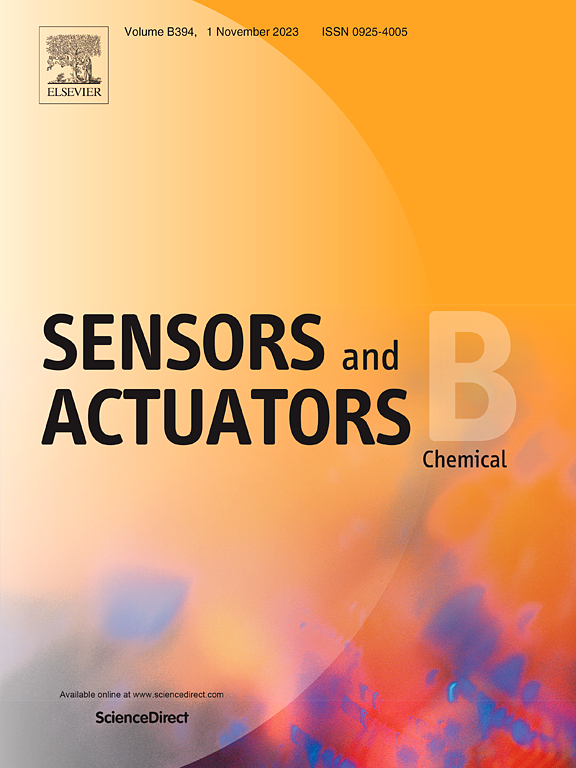两步水热合成α-MoO3@ZIF-8纳米剑:提高氨检测选择性和响应值的有效策略
IF 8
1区 化学
Q1 CHEMISTRY, ANALYTICAL
引用次数: 0
摘要
通过水热法在 Al2O3 陶瓷管上成功合成了 α-MoO3 纳米剑。随后,以α-MoO3 纳米字为核心,通过第二个水热合成步骤制造出了α-MoO3@ZIF-8 复合材料。ZIF-8 材料的多级微孔结构可实现选择性气体屏蔽,有效阻隔敏感材料与干扰气体的接触。气体传感实验结果表明,与纯 α-MoO3 相比,α-MoO3@ZIF-8 复合材料对目标气体(NH3)的选择性明显增强。具体而言,对三乙醇胺的响应值从 116.0 降至 7.4,而对 NH3 的响应值则从 20.3 升至 36.5。为了阐明 α-MoO3@ZIF-8 复合材料的气体传感机理,我们进行了分子动力学(MD)模拟,以研究 ZIF-8 的气体吸附特性。此外,还利用密度泛函理论(DFT)模拟研究了 α-MoO3 和 α-MoO3@ZIF-8 对 NH3 的吸附。模拟结果表明,这两种材料对 NH3 的吸附都是一个化学吸附过程。此外,还利用部分状态密度 (PDOS)、电荷密度差和 Hirshfeld 电荷分析表征了 NH3 与材料表面的相互作用。本文章由计算机程序翻译,如有差异,请以英文原文为准。

Two-step hydrothermal synthesis of α-MoO3@ZIF-8 nanoswords: An effective strategy to improve the selectivity and response value of ammonia detection
The α-MoO3 nanoswords were successfully synthesized on Al2O3 ceramic tubes via a hydrothermal method. Subsequently, α-MoO3@ZIF-8 composites were fabricated in a second hydrothermal synthesis step, utilizing the α-MoO3 nanoswords as the core. The ZIF-8 material's multistage microporous structure enables selective gas screening, effectively blocking the contact between sensitive materials and interfering gases. Gas-sensing experimental results indicated that the α-MoO3@ZIF-8 composite exhibited a significantly enhanced selectivity towards the target gas (NH3) compared to pure α-MoO3. Specifically, the response value to TEA decreased from 116.0 to 7.4, while the response value to NH3 increased from 20.3 to 36.5. To elucidate the gas-sensing mechanism of the α-MoO3@ZIF-8 composite, molecular dynamics (MD) simulations and grand canonical Monte Carlo (GCMC) method were conducted to investigate the gas adsorption properties of ZIF-8. Additionally, the adsorption of NH3 by both α-MoO3 and α-MoO3@ZIF-8 was studied using density functional theory (DFT) simulations. These simulations revealed that the adsorption of NH3 on both materials is a chemisorption process. Furthermore, the interaction of NH3 with the material surfaces was characterized using partial density of states (PDOS), charge density difference, and Hirshfeld charge analysis.
求助全文
通过发布文献求助,成功后即可免费获取论文全文。
去求助
来源期刊

Sensors and Actuators B: Chemical
工程技术-电化学
CiteScore
14.60
自引率
11.90%
发文量
1776
审稿时长
3.2 months
期刊介绍:
Sensors & Actuators, B: Chemical is an international journal focused on the research and development of chemical transducers. It covers chemical sensors and biosensors, chemical actuators, and analytical microsystems. The journal is interdisciplinary, aiming to publish original works showcasing substantial advancements beyond the current state of the art in these fields, with practical applicability to solving meaningful analytical problems. Review articles are accepted by invitation from an Editor of the journal.
 求助内容:
求助内容: 应助结果提醒方式:
应助结果提醒方式:


